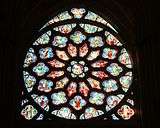Édouard Didron
Édouard Didron (1836-1902) was a French stained glass artist and art writer.
Édouard Didron | |
|---|---|
| Born | 13 October 1836 Paris |
| Died | 14 April 1902 (aged 65) Paris |
| Nationality | French |
| Occupation | Stained glass artist |
| Parent(s) | Mr Fiot Ms Didron |
| Relatives | Adolphe Napoléon Didron (uncle) |
Biography
Early life
Édouard Amedée Didron was born on 13 October 1836 in Paris.[1] His father was Mr Fiot and his mother, Ms Didron. His uncle, the archeologist and art historian Adolphe Napoléon Didron (1806-1867), adopted him.[1]
Career
He designed the stained glass in the Église Saint-Vincent-de-Paul in Marseille.[2] He also designed stained glass in the Église Sainte-Rosalie in Paris, the Église Saint-Christophe in Cergy, the Église Saint-Ouen in Le Tronquay, the Église Notre-Dame in Neufchâtel-en-Bray, the Cathédrale Saint-Maclou de Pontoise in Pontoise, the Basilica of St. Sernin in Toulouse, the Eglise Notre Dame de Carentan and the Cathédrale Saint-Front de Périgueux in Périgueux.
Additionally, he wrote many books about art.[1] He denounced the "bastardization" of Gothic art, which meant the decoration of bars and private residences with medieval and mock-medieval works.[3] He was also the editor of Annales Archéologiques from 1867 to 1872.[1]
Death
He died on 14 April 1902 in Paris.[1]
Bibliography
- Nicolas-Marie-Joseph Chapuy, Édouard Didron, Allemagne monumentale et pittoresque: ou ses vues et ses monuments (accompagnés de notes historiques) (Goupil & Vibert, 1845).[4]
- Édouard Didron, Vitraux du Grand-Andely, (Librairie archéologique de Victor Didron, 1863).[5]
- Édouard Didron, Les vitraux à l'expossition universelle de 1867 (Librairie archéologique de Victor Didron, 1868).[6][7]
- Édouard Didron, Quelques Mots sur l'Art Chrétien à propos de l'Image du Sacré-Cœur (1874).[8]
- Édouard Didron, Louis Clémandot, Exposition Universelle Internationale de 1878 À Paris. Groupe III. Classe 19. Rapport Sur Les Cristaux, la Verrerie, Et Les Vitraux. (1880).[9]
- Édouard Didron, Catalogue de la bibliothèque iconographique et archéologique de feu (Emile-Paul, 1903, 87 pages).[10]
Gallery
 Stained glass inside the Église Saint-Vincent-de-Paul in Marseille
Stained glass inside the Église Saint-Vincent-de-Paul in Marseille- Stained glass inside the Église Sainte-Rosalie in Paris
- Stained glass inside the Église Saint-Christophe in Cergy
- Stained glass representing Archbishop François de Harlay inside the Église Saint-Ouen in Le Tronquay
- Stained glass representing Archbishop Jean de Marigny inside the Église Saint-Ouen in Le Tronquay
- Stained glass inside the Église Saint-Ouen in Le Tronquay
- Stained glass inside the Église Saint-Ouen in Le Tronquay
- Stained glass inside the Église Notre-Dame in Neufchâtel-en-Bray
- Stained glass inside the Église Notre-Dame in Neufchâtel-en-Bray
- Stained glass inside the Église Notre-Dame in Neufchâtel-en-Bray
- Stained glass inside the Église Notre-Dame in Neufchâtel-en-Bray
- Stained glass inside the Église Notre-Dame in Neufchâtel-en-Bray
- Stained glass inside the Cathédrale Saint-Maclou de Pontoise
- Stained glass inside the Cathédrale Saint-Maclou de Pontoise
- Stained glass inside the Cathédrale Saint-Maclou de Pontoise
- Stained glass inside the Cathédrale Saint-Maclou de Pontoise
- Stained glass inside the Cathédrale Saint-Maclou de Pontoise
 Stained glass inside the Basilica of St. Sernin, Toulouse
Stained glass inside the Basilica of St. Sernin, Toulouse- Stained glass inside the Cathédrale Saint-Front de Périgueux
- Stained glass inside the Cathédrale Saint-Front de Périgueux
- Stained glass inside the Cathédrale Saint-Front de Périgueux
- Stained glass inside the Cathédrale Saint-Front de Périgueux
- Stained glass inside the Cathédrale Saint-Front de Périgueux
- Stained glass inside the Cathédrale Saint-Front de Périgueux
- Stained glass inside the Cathédrale Saint-Front de Périgueux
- Stained glass inside the Cathédrale Saint-Front de Périgueux
- Stained glass inside the Cathédrale Saint-Front de Périgueux
- Stained glass inside the Cathédrale Saint-Front de Périgueux
- Stained glass inside the Cathédrale Saint-Front de Périgueux
- Stained glass inside the Cathédrale Saint-Front de Périgueux
- Stained glass inside the Cathédrale Saint-Front de Périgueux
- Stained glass inside the Cathédrale Saint-Front de Périgueux
- Stained glass inside the Cathédrale Saint-Front de Périgueux
- Stained glass inside the Cathédrale Saint-Front de Périgueux
- Stained glass inside the Cathédrale Saint-Front de Périgueux
- Stained glass inside the Cathédrale Saint-Front de Périgueux
- Stained glass inside the Cathédrale Saint-Front de Périgueux
- Stained glass inside the Cathédrale Saint-Front de Périgueux
- Stained glass inside the Cathédrale Saint-Front de Périgueux
- Stained glass inside the Cathédrale Saint-Front de Périgueux
- Stained glass inside the Cathédrale Saint-Front de Périgueux
- Stained glass inside the Cathédrale Saint-Front de Périgueux
References
- Dictionary of Art Historians: Didron, Adolphe Napoléon
- Dominique Auzias, Marseille 2013 Petit Futé, Le Petit Futé, 4 Apr 2013, p. 388
- Elizabeth Nicole Emery, Laura Morowitz, Consuming the Past: The Medieval Revival in Fin-de-siècle France, Ashgate Publishing, 2003, p. 119
- Google Books
- Google Books
- Google Books
- Bibliothèque nationale de France
- Google Books
- Google Books
- Google Books